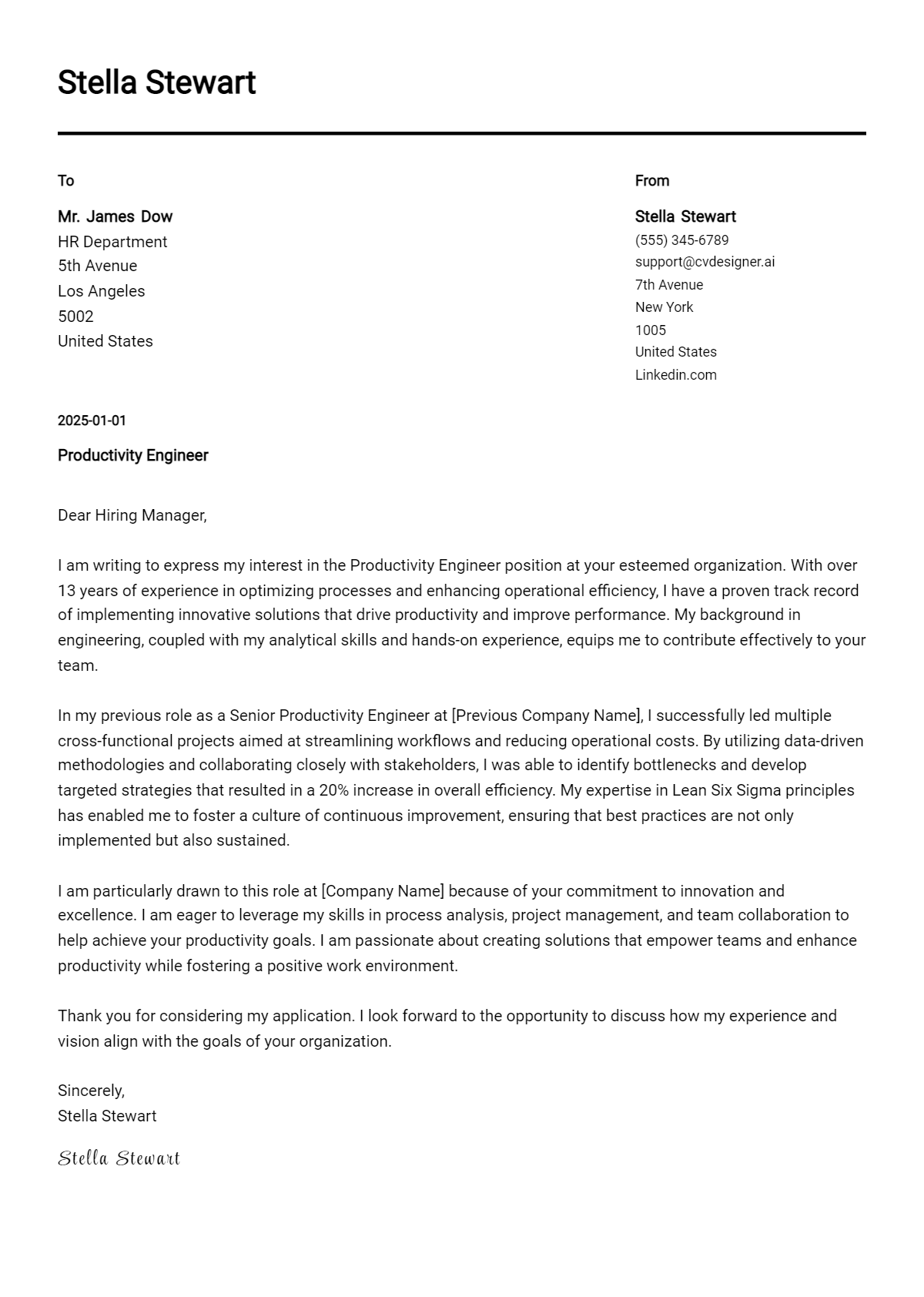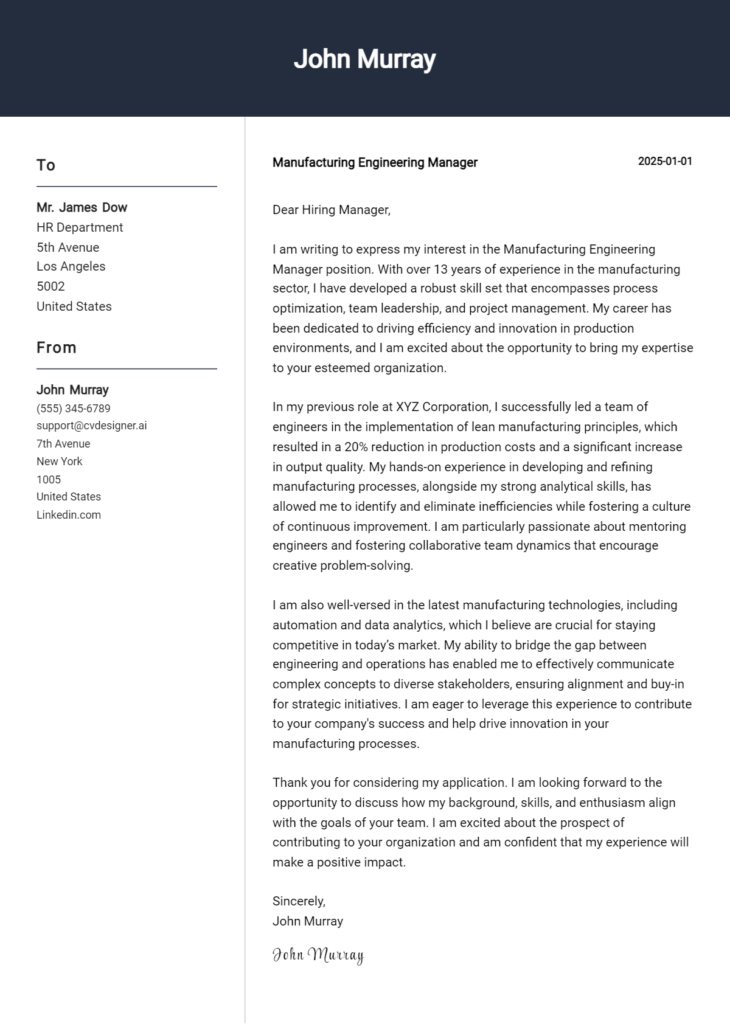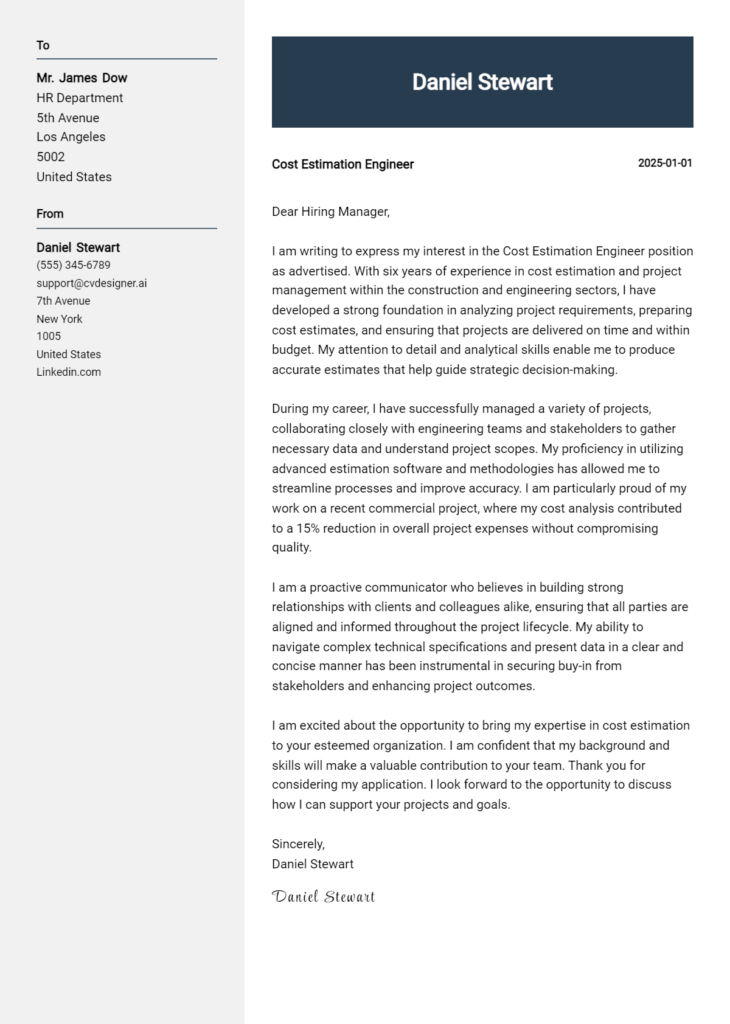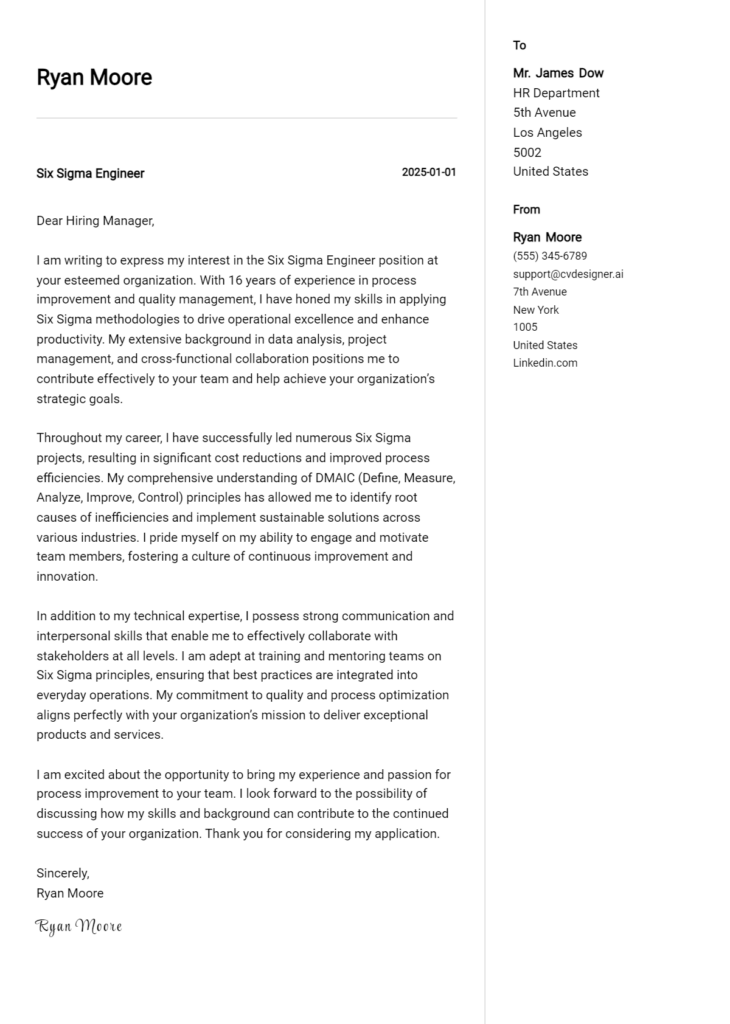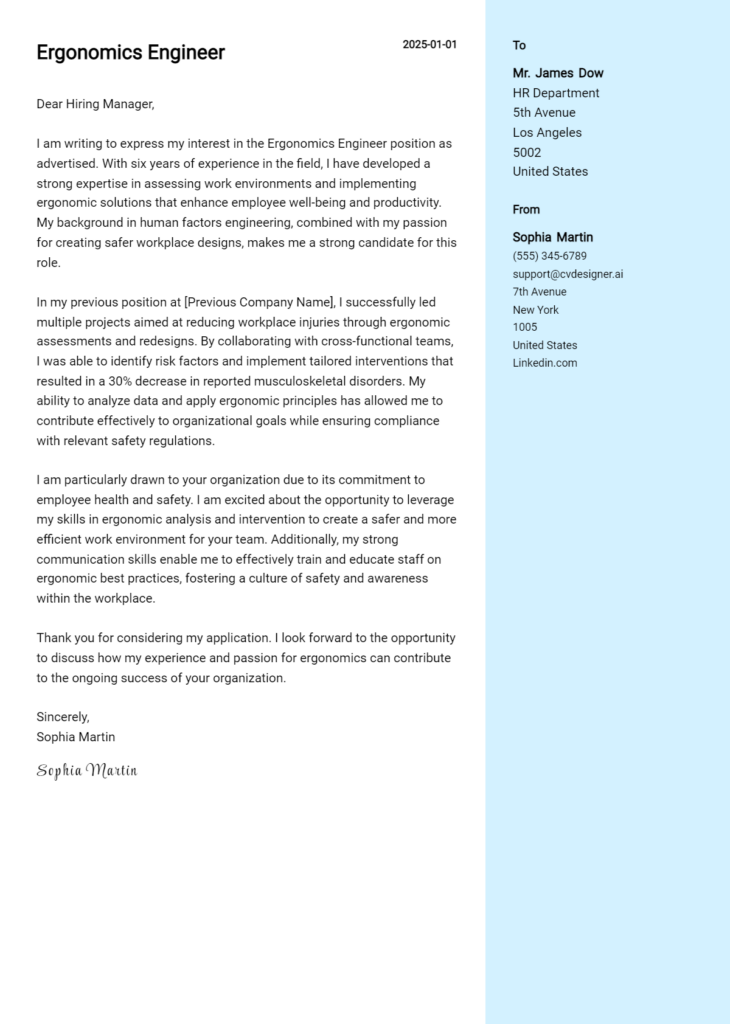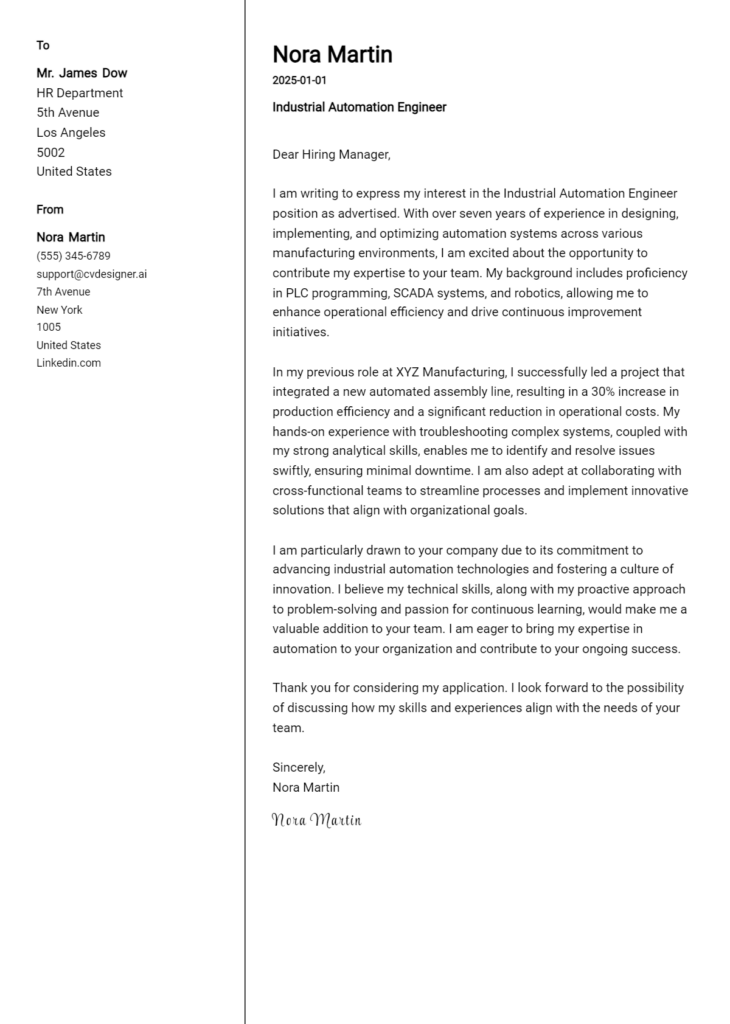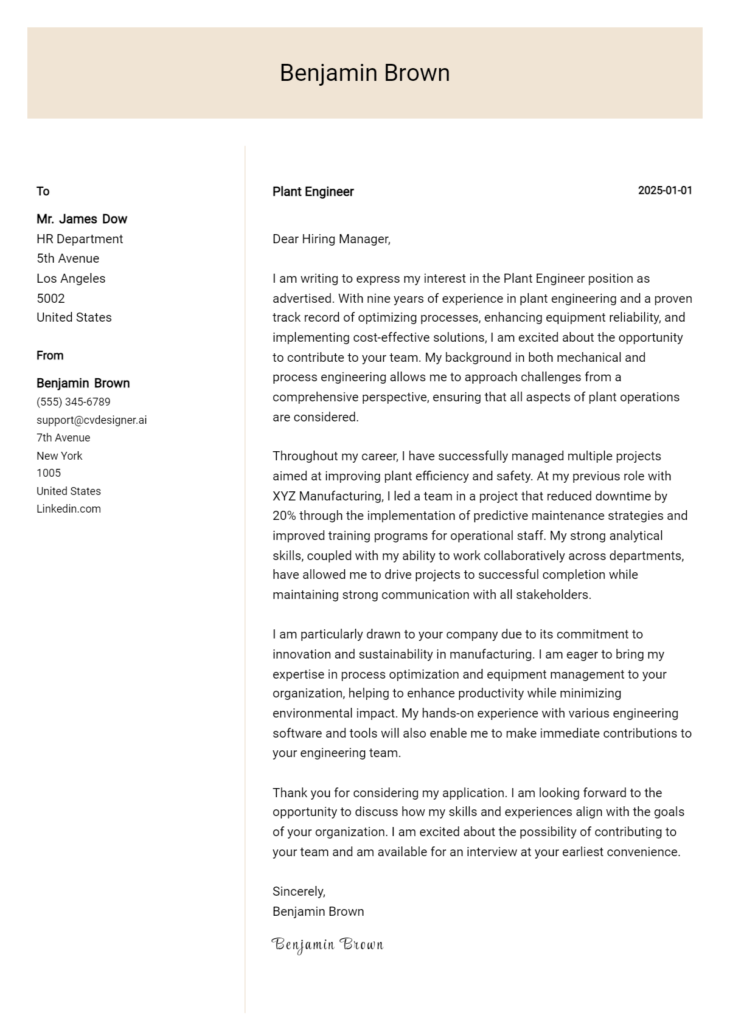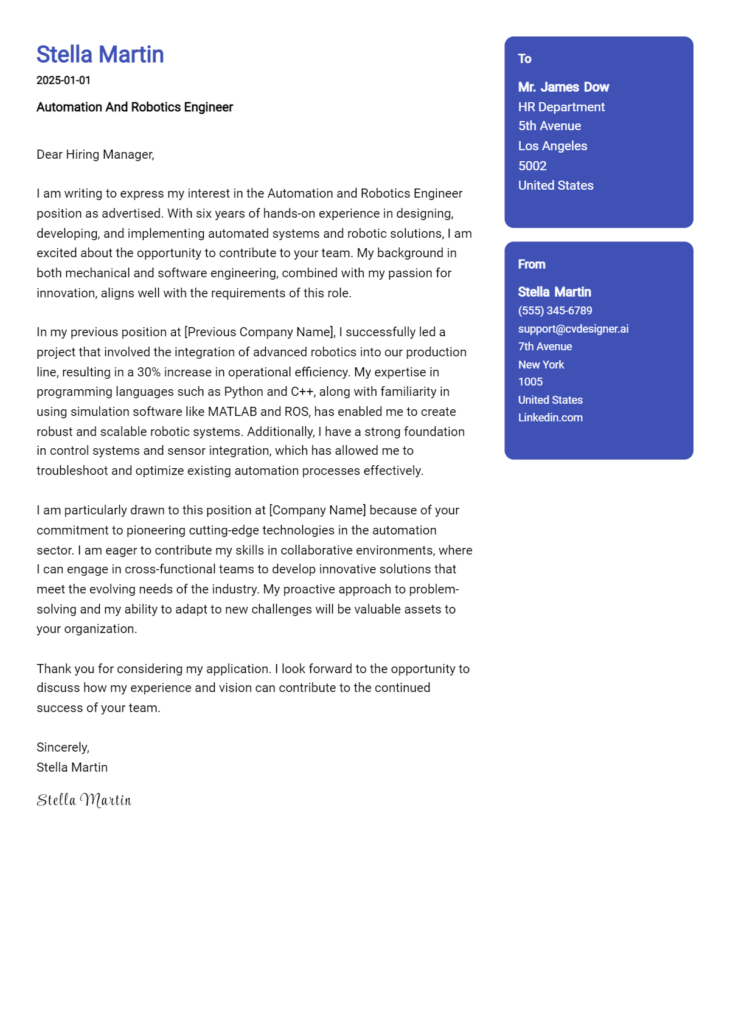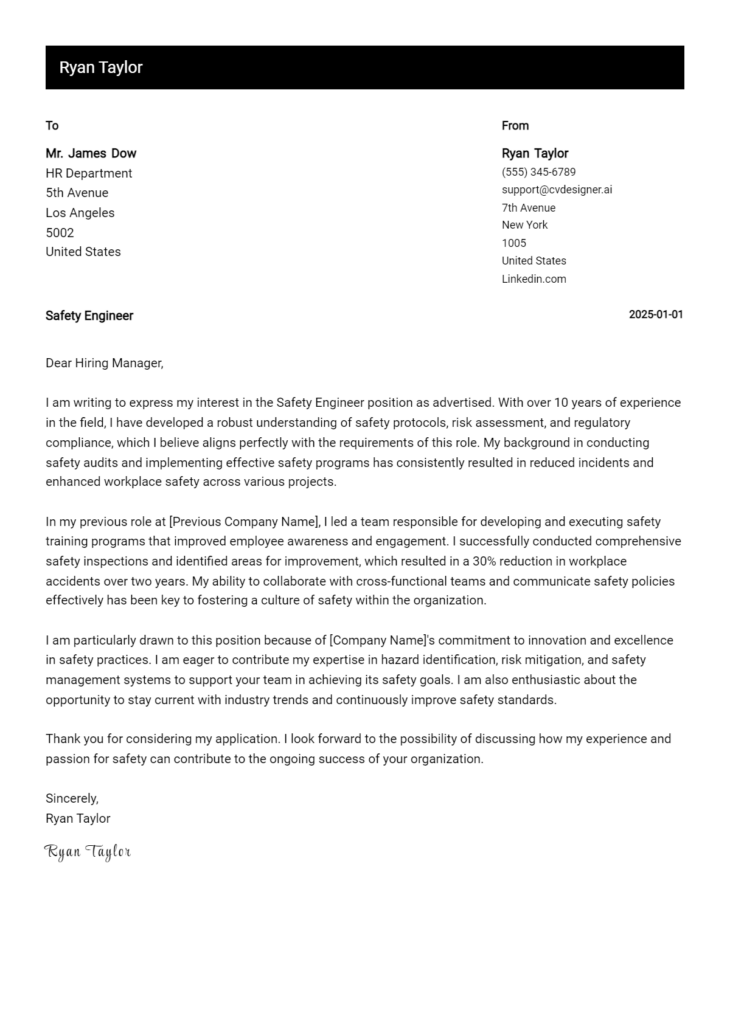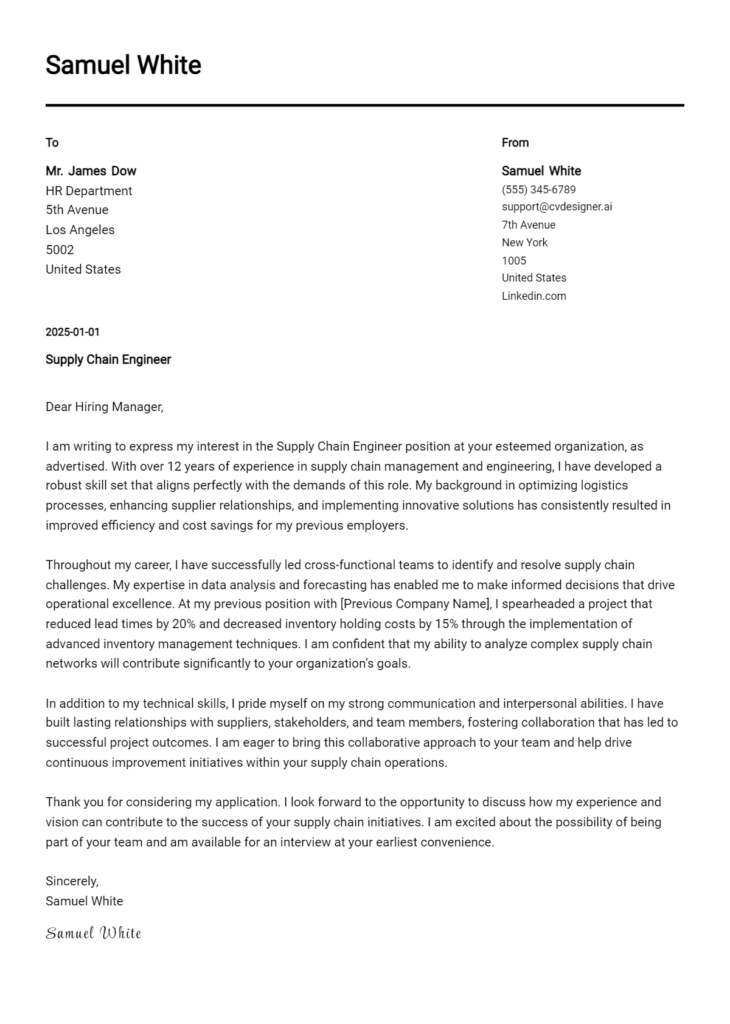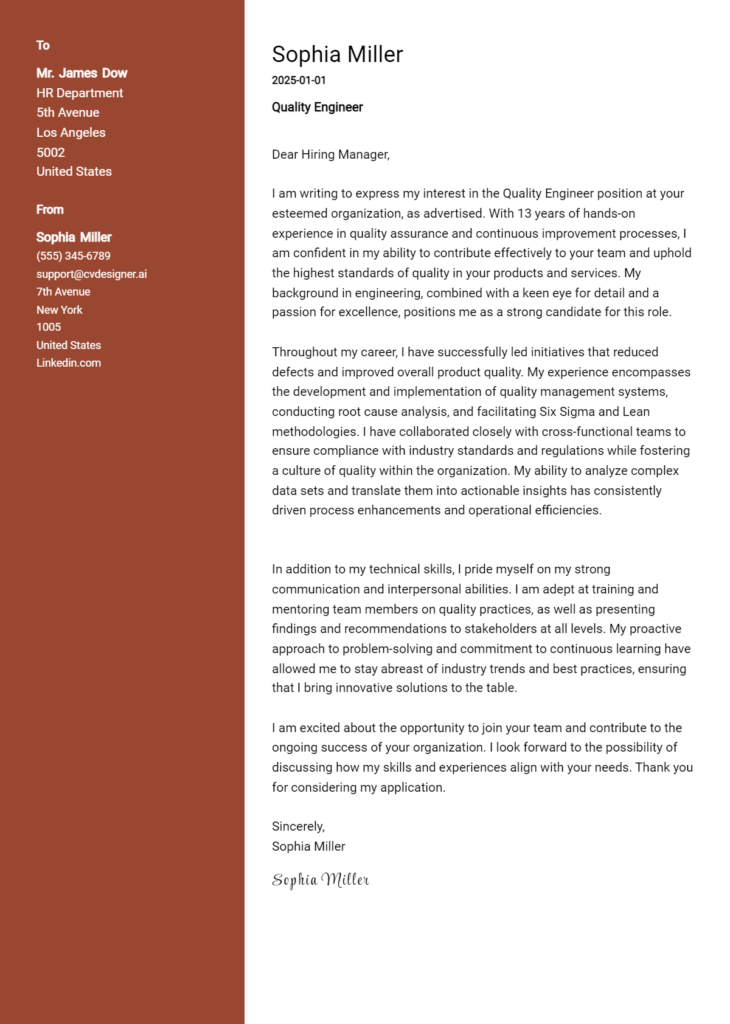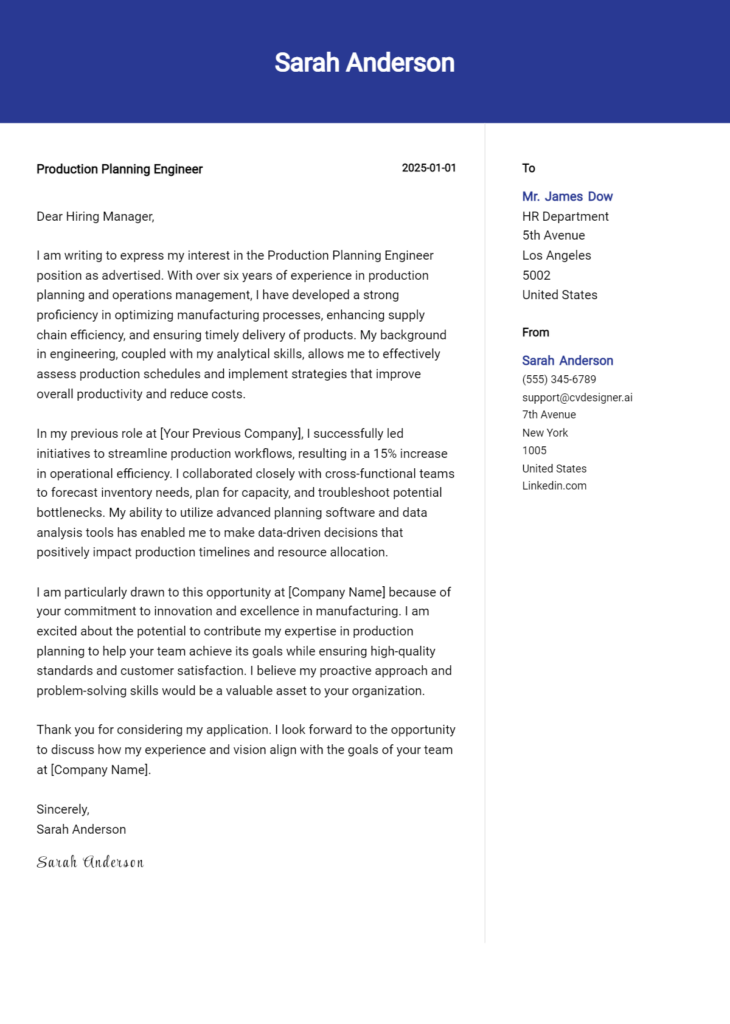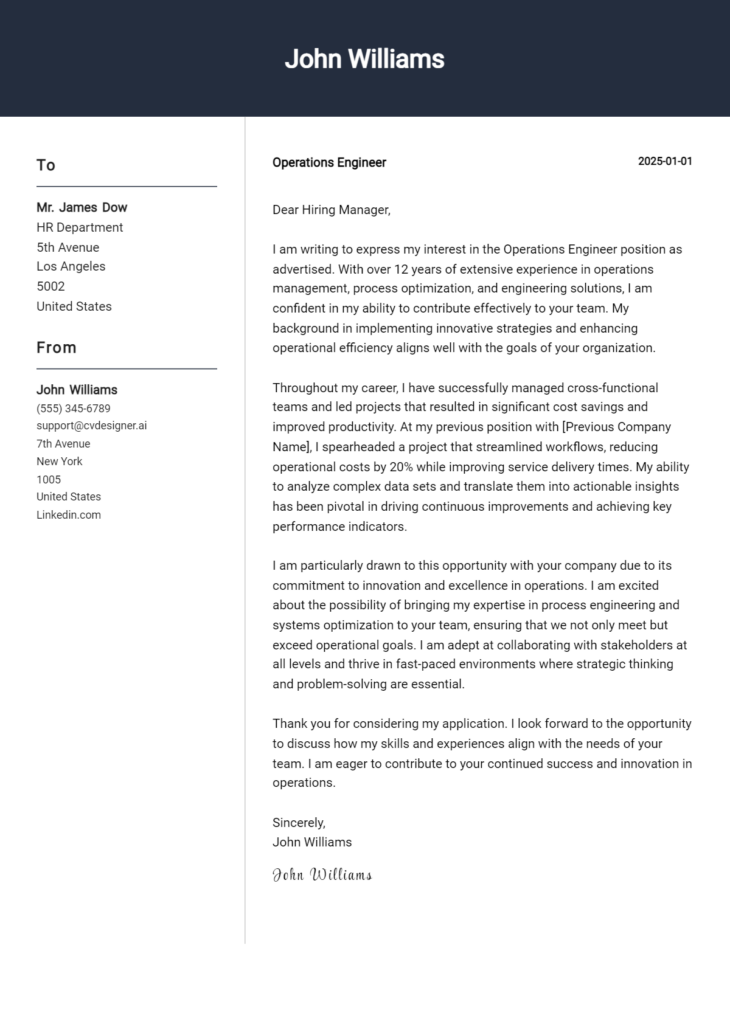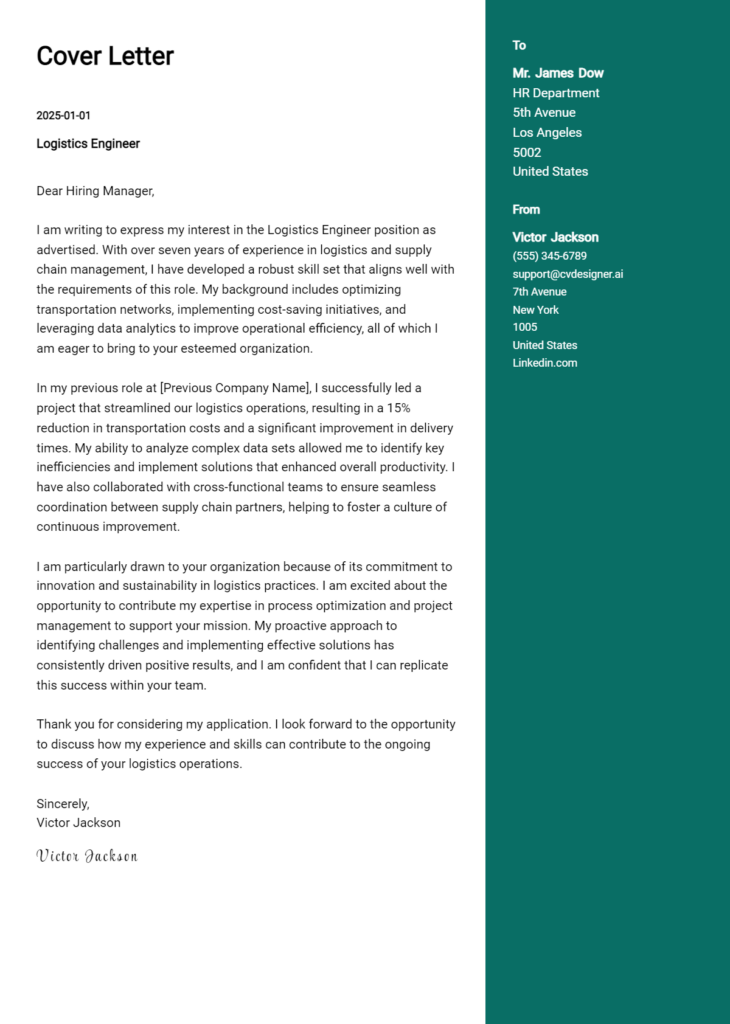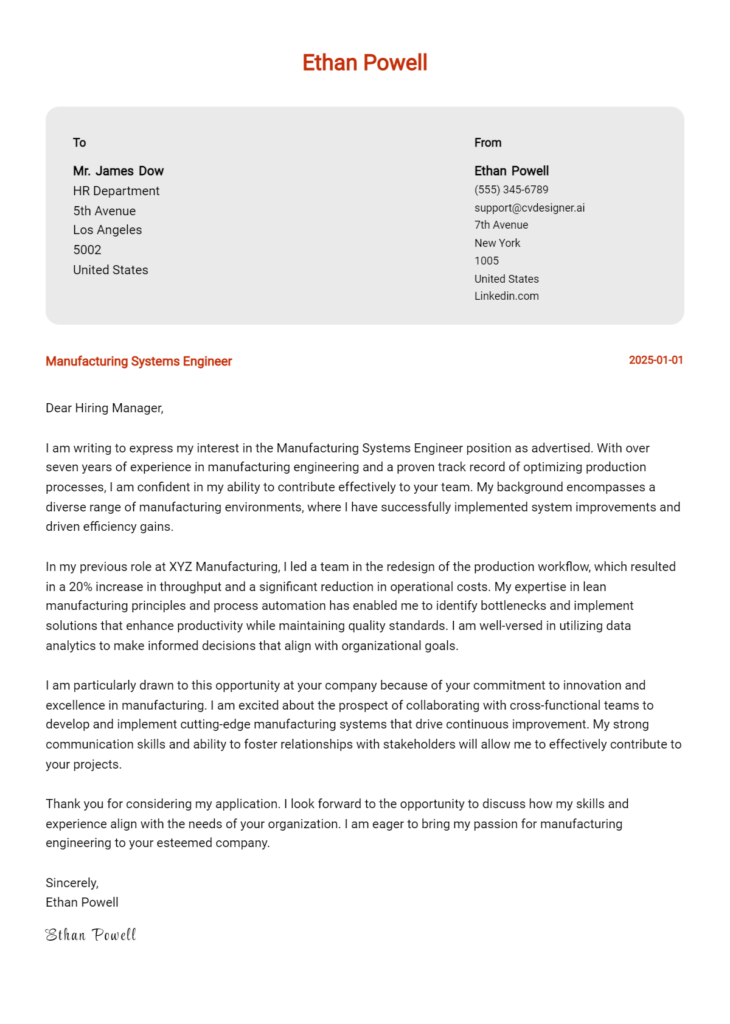Productivity Engineer Cover Letter Examples
Explore additional Productivity Engineer cover letter samples and guides and see what works for your level of experience or role.
How to Format a Productivity Engineer Cover Letter?
Crafting a well-structured cover letter is essential for a Productivity Engineer, as it serves as your first impression to potential employers. The way you format your cover letter not only showcases your qualifications but also demonstrates your analytical skills and commitment to efficiency—traits that are paramount in the field of productivity engineering. A well-organized cover letter can effectively communicate your problem-solving abilities and attention to detail, making it easier for hiring managers to see your fit for their team.
In this guide, we will explore how to structure your cover letter, providing insights and examples tailored to the productivity engineering role.
We will focus on the essential components of a professional cover letter, including:
- Cover Letter Header
- Cover Letter Greeting
- Cover Letter Introduction
- Cover Letter Body
- Cover Letter Closing
Each section plays a crucial role in highlighting your qualifications and professionalism. Let’s break down each part and explain how to make your productivity engineer cover letter stand out.
Importance of the Cover Letter Header for a Productivity Engineer
The header of a cover letter serves as the first impression for potential employers, making it crucial for a Productivity Engineer to present their information clearly and professionally. A well-structured header provides essential contact information, including the applicant's name, phone number, email address, and the date, followed by the recipient's details, such as the hiring manager's name and company address. Clarity in this section not only reflects the applicant's attention to detail but also sets a professional tone for the rest of the application.
Below are examples of a strong and weak cover letter header for a Productivity Engineer position.
Strong Example
John Doe 123 Productivity Lane Efficiency City, ST 12345 (123) 456-7890 johndoe@email.com October 1, 2023 Jane Smith Hiring Manager Tech Innovations Inc. 456 Improvement Ave Optimized Town, ST 67890
Weak Example
johndoe@email.com 10/01/23 Hey there, I’m John Doe. I want to apply for the Productivity Engineer job.
The Importance of the Cover Letter Greeting for a Productivity Engineer
The cover letter greeting is a crucial element that sets the tone for the rest of your letter. It is the first impression you make on the hiring manager, and a well-crafted greeting can demonstrate your professionalism and attention to detail. By addressing the hiring manager directly, you not only personalize your application but also convey your genuine interest in the position. Avoiding generic greetings such as "To Whom It May Concern" shows that you have taken the time to research the recipient's name, which can enhance your candidacy. If necessary, consider leveraging LinkedIn or the company’s website to find the hiring manager's name.
Here are some strong and weak examples of greetings for a Productivity Engineer cover letter:
Strong Greeting Example:
Dear Ms. Johnson,
Weak Greeting Example:
To Whom It May Concern,
The Importance of a Compelling Cover Letter Introduction for a Productivity Engineer
A well-crafted cover letter introduction is crucial for a Productivity Engineer as it serves as the first impression to the hiring manager. This opening paragraph should not only capture attention but also convey genuine interest in the position, while briefly showcasing relevant skills and noteworthy achievements. An effective introduction sets the tone for the rest of the letter, paving the way for a compelling narrative about the candidate's qualifications and fit for the role. Below are examples of strong and weak cover letter introductions for a Productivity Engineer.
Strong Example
Dear [Hiring Manager's Name], As a dedicated Productivity Engineer with over five years of experience in optimizing workflows and enhancing operational efficiency, I was thrilled to discover the opening at [Company Name]. My passion for leveraging data-driven approaches to streamline processes, coupled with my recent achievement of reducing project turnaround time by 30%, aligns perfectly with your team's commitment to excellence. I am excited about the opportunity to contribute my expertise in process improvement to drive success at [Company Name].
Weak Example
Dear Sir/Madam, I am writing to apply for the Productivity Engineer position. I have some experience in engineering and I think I could do well in this role. I hope you will consider my application, and I look forward to hearing from you.
Purpose of the Cover Letter Body for a Productivity Engineer
The cover letter body for a Productivity Engineer serves as a critical component in presenting the candidate's skills, experiences, and overall value to the company. It is an opportunity to highlight specific projects and accomplishments that demonstrate the candidate's ability to improve processes, increase efficiency, and drive results. This section allows the candidate to connect their technical expertise with the company’s goals, showcasing how their contributions can lead to operational enhancements and cost savings. By illustrating past achievements with quantifiable metrics or successful project outcomes, the candidate can effectively position themselves as a valuable asset to the organization.
Strong Example
In my previous role at XYZ Corporation, I led a cross-functional team in a process optimization project that resulted in a 30% reduction in production downtime. By implementing a new scheduling system and introducing predictive maintenance strategies, we not only improved operational efficiency but also saved the company over $500,000 annually. Additionally, I successfully developed and rolled out a training program for staff that enhanced their engagement and productivity, leading to a 15% increase in overall output. I am excited about the possibility of bringing my expertise in Lean methodologies and data analysis to your team, where I am confident I can contribute to further driving productivity improvements.
Weak Example
I have worked in various engineering roles for several years. I am good at making things work better and have some experience with process improvements. In my last job, I did some projects that may have helped the company. I think I can be a great addition to your team, and I would like to talk about opportunities to improve productivity.
Importance of the Cover Letter Closing for a Productivity Engineer
The closing paragraph of a cover letter is crucial for a Productivity Engineer as it serves as the final opportunity to summarize qualifications, express enthusiasm for the role, and prompt the hiring manager to take action, such as reviewing the resume or scheduling an interview. A well-crafted closing can reinforce the candidate's fit for the position and leave a lasting impression, while a weak closing may fail to convey the candidate's strengths and could diminish their chances of moving forward in the hiring process.
Strong Example
Thank you for considering my application for the Productivity Engineer position. With my extensive background in process optimization and a proven track record of implementing effective productivity solutions, I am excited about the opportunity to contribute to your team. I believe my skills align perfectly with the goals of your organization, and I look forward to the possibility of discussing my application in further detail. Please feel free to review my resume, and I hope to schedule an interview at your earliest convenience.
Weak Example
I appreciate your time. I think I might be a good fit for the job, so let me know if you want to talk. You can look at my resume if you want to. Thanks.
Crafting an effective cover letter for a Productivity Engineer position is crucial for making a strong first impression. A well-written cover letter not only highlights your technical skills but also demonstrates your problem-solving abilities, knowledge of the Software Development Life Cycle (SDLC), and capacity for teamwork. Additionally, expressing your passion for continuous learning can set you apart from other candidates. The following tips will guide you in creating a compelling cover letter that captures these essential qualities.
Tips for Writing an Effective Cover Letter for a Productivity Engineer
Highlight Technical Skills
Clearly outline the technical skills relevant to the Productivity Engineer role, such as proficiency in programming languages, automation tools, and data analysis software. Make sure to provide specific examples of how you have applied these skills in your previous positions. This not only shows your competence but also your ability to contribute to the team’s objectives.Demonstrate Problem-Solving Abilities
Showcase your problem-solving skills by describing a challenging situation you faced in a previous role and how you resolved it. Use quantifiable results to illustrate the impact of your solutions. This will convey your analytical mindset and your capability to improve productivity through innovative solutions.Emphasize SDLC Knowledge
Mention your understanding of the Software Development Life Cycle (SDLC) and how it informs your approach to productivity engineering. Discuss your experience in various stages of the SDLC and how you have contributed to optimizing processes, ensuring quality, and enhancing collaboration among team members.Showcase Teamwork and Collaboration
Productivity engineering often requires collaboration with cross-functional teams. Share examples that illustrate your ability to work effectively with others, resolve conflicts, and achieve common goals. Highlight any roles you have played in team projects that led to successful outcomes.Express a Passion for Continuous Learning
The tech landscape is ever-evolving, and a commitment to continuous learning is essential for a Productivity Engineer. Mention any ongoing education, certifications, or professional development activities you are engaged in. This demonstrates your proactive approach to staying updated with industry trends and technologies, making you a valuable asset to any team.
For additional resources, consider exploring these cover letter templates and utilize a cover letter builder to help format your letter professionally.
Common Mistakes to Avoid in a Productivity Engineer Cover Letter
Avoiding common mistakes in a cover letter is crucial for standing out as a candidate for a Productivity Engineer position. A well-crafted cover letter can showcase your skills and enthusiasm, while errors can undermine your professionalism. Here are some frequent pitfalls to watch out for:
- Generic Content: Using a one-size-fits-all approach can make your letter feel impersonal. Tailor your cover letter to highlight specific experiences relevant to the Productivity Engineer role.
- Ignoring Job Description: Failing to reference the job description can lead to missing key qualifications. Carefully read the job listing and align your skills with the requirements mentioned.
- Overly Complex Language: Using jargon or overly technical language can confuse readers. Aim for clarity and simplicity to convey your points effectively.
- Lack of Specific Examples: Vague statements don't showcase your abilities. Include quantifiable achievements to demonstrate your contributions in previous roles.
- Neglecting Formatting: A poorly formatted cover letter can detract from your message. Follow a professional cover letter format to ensure readability and structure.
- Spelling and Grammar Errors: Typos can create a negative impression. Proofread your letter multiple times and consider having someone else review it.
- Failing to Express Enthusiasm: Not conveying your passion for the role can make your application forgettable. Clearly express your interest in the company and the position to make a memorable impact.
For inspiration, you can explore various cover letter examples to see how to effectively structure and personalize your cover letter. Avoiding these mistakes will help you present a compelling case for your candidacy as a Productivity Engineer.
Cover Letter FAQs for Productivity Engineer
What should I include in my cover letter as a Productivity Engineer?
In your cover letter, focus on showcasing your relevant technical skills, problem-solving abilities, and experience in process optimization. Start with a strong introduction that captures the hiring manager's attention. Highlight specific projects or initiatives where you successfully increased efficiency or reduced waste. Use metrics to quantify your achievements, such as percentage improvements in productivity or cost savings. Additionally, mention your familiarity with tools and methodologies like Lean, Six Sigma, or Agile, as these are crucial in productivity engineering. Finally, express your enthusiasm for the role and the company, explaining why you are a great fit for their team.
How can I tailor my cover letter for a specific job application?
To tailor your cover letter, start by thoroughly researching the company and its culture, values, and current projects. Identify key skills and qualifications mentioned in the job description, and align your experiences with these requirements. Use specific language from the job posting to demonstrate your fit. For instance, if the job emphasizes collaboration, include examples of how you've effectively worked in cross-functional teams. Additionally, mention any relevant industry experience or knowledge that connects you to the company's mission. Personalizing your cover letter shows genuine interest and effort, making you a more attractive candidate.
How long should my cover letter be?
Your cover letter should typically be one page long, consisting of three to four paragraphs. Aim for around 250 to 400 words, which is an ideal length to convey your qualifications without overwhelming the reader. Start with a compelling introduction, followed by paragraphs that detail your relevant experiences, skills, and achievements. Conclude with a strong closing statement that reiterates your interest in the position and invites further discussion. A concise, focused cover letter demonstrates your ability to communicate effectively, a crucial skill for a Productivity Engineer.
Should I include technical skills in my cover letter?
Absolutely! Including technical skills in your cover letter is essential for a Productivity Engineer role. Highlight any relevant software tools, programming languages, or methodologies you are proficient in, such as data analysis tools (R, Python), project management software (JIRA, Trello), or process improvement techniques (Lean, Six Sigma). Be specific about how these skills have contributed to your past successes in improving productivity or optimizing processes. Providing concrete examples will not only showcase your expertise but also demonstrate your ability to apply these skills in real-world situations, which is crucial for potential employers.
Build your Cover Letter in minutes
Use an AI-powered cover letter builder and have your letter done in 5 minutes. Just select your template and our software will guide you through the process.

